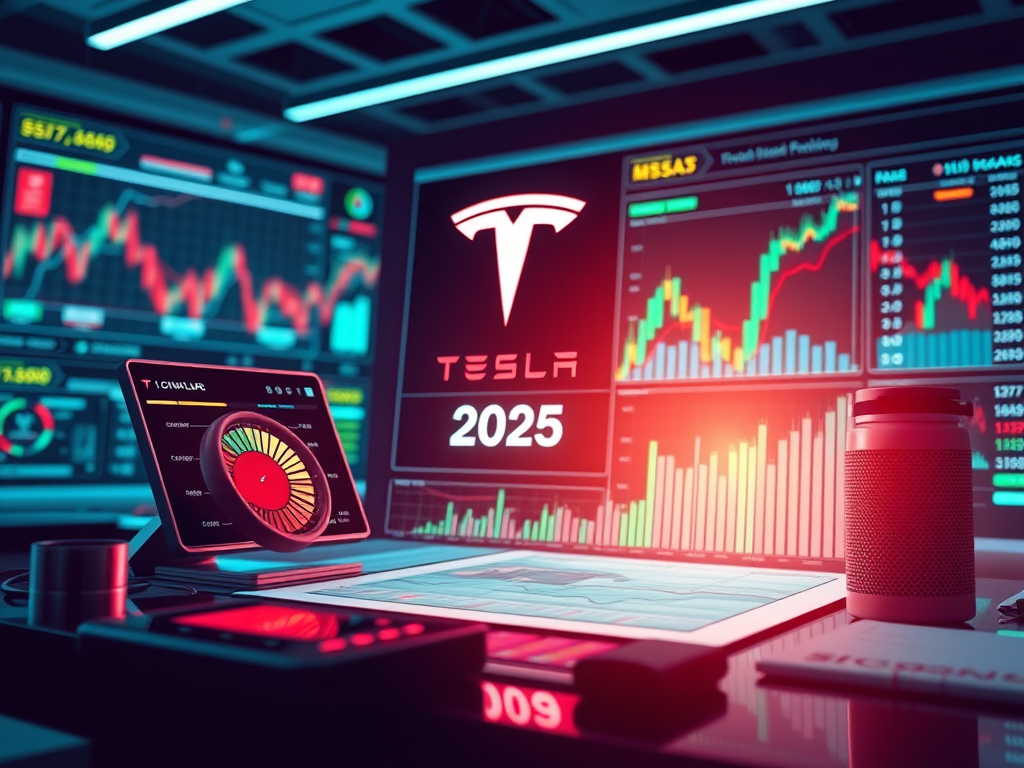Tesla Inc. (NASDAQ: TSLA), led by Elon Musk, continues to be one of the most watched and debated stocks in the global market. As of July 2025, TSLA is trading around $312–318, rebounding from recent lows but still facing intense scrutiny over falling deliveries, growing competition, and the company’s strategic shift toward autonomous driving.
This article provides a detailed analysis of Tesla’s stock performance, financial indicators, delivery numbers, robotaxi ambitions, risks, and long-term investment outlook.

📊 Recent Stock Performance & Financials
In Q2 2025, Tesla reported deliveries of 384,122 vehicles, down 13% year-over-year, marking the sharpest quarterly decline in the company’s history. Despite this, the stock rebounded slightly due to expectations that the worst was already priced in.
- Current Price: $312.88 (as of July 2, 2025)
- 52-Week Range: $188 – $488
- Market Cap: ~$1 Trillion
- P/E Ratio: 75+
- 12-Month Analyst Target: ~$291 average
While Tesla remains a high-valuation stock, its fundamentals are under pressure. Revenue growth is slowing, and margins are narrowing due to price wars and increased global competition, especially from China.
🚗 Q2 Deliveries: What They Reveal
Tesla’s Q2 deliveries missed bullish expectations but landed slightly above bearish estimates. However, the details show weakening demand across multiple regions:
- Europe: Down 37% YoY, with particularly steep drops in Germany and France.
- China: Declined over 10%, as local rivals like Xiaomi and BYD gained ground.
- USA: Registrations fell 9% YTD, reflecting consumer fatigue and limited new model launches.
This decline shows that Tesla’s once-dominant position in the EV market is no longer unchallenged.
🧠 Robotaxi & AI: A Bold New Frontier
In June 2025, Tesla rolled out a limited robotaxi service in Austin, Texas. This move excited investors, driving the stock up over 8% before a pullback. Elon Musk has positioned Tesla’s Full Self-Driving (FSD) software and Dojo supercomputer as central to the company’s future.
Key Points:
- Tesla’s camera-based FSD system aims to eliminate the need for expensive LIDAR or radar.
- The Dojo AI platform accelerates training of driving models.
- Robotaxis could generate $30–50 billion in annual recurring revenue by 2030 if scaled successfully.
Analyst View:
Some analysts, like Benchmark’s Mickey Legg, raised TSLA’s price target to $475, citing robotaxi potential. However, others warn that regulatory delays and safety issues may hinder progress.
🇨🇳 Competition in China: Tesla’s Toughest Market
Tesla is under attack in China—the world’s largest EV market.
- Xiaomi launched the YU7, a direct rival to Tesla’s Model Y.
- The Xiaomi SU7 sedan has consistently outsold Tesla’s Model 3 in recent months.
- Domestic brands are offering cheaper, tech-packed EVs with faster updates.
These Chinese automakers benefit from local subsidies, lower manufacturing costs, and faster production cycles. Tesla’s aging lineup and fewer incentives in China put pressure on market share and pricing power.
🔥 Brand Risks & Elon Musk’s Political Persona
Elon Musk’s controversial presence on social media and outspoken political views are beginning to affect Tesla’s brand.
- In Europe, consumer boycotts are reported, especially in Germany and France.
- Musk’s political clashes, including opposition to certain U.S. policies, have led to threats of subsidy withdrawal.
- In the U.K., Q1 Tesla sales dropped 49% YoY.
This reputational damage adds a unique layer of volatility not found in most other stocks.
📈 Valuation & Analyst Sentiment
Tesla’s valuation remains high despite its challenges.
| Metric | Value |
|---|---|
| P/E Ratio | ~75 |
| Forward P/E | ~58 |
| Analyst Rating | 37 analysts – Mostly “Hold” |
| Price Targets | $475 (Bull case) to $180 (Bear case) |
According to Alpha Spread, Tesla’s intrinsic value is only around $55 per share, implying that the current market price is overvalued by 80%. On the other hand, long-term believers argue that Tesla is not just a car company—it’s a tech, AI, and energy company.
📌 Investment Outlook: Should You Buy TSLA in 2025?
✅ Bullish Case:
- Successful robotaxi launch and mass adoption by 2026
- FSD becomes widely available, increasing recurring software revenue
- Expansion into AI, robotics, and energy
❌ Bearish Case:
- EV sales continue to decline in key markets
- Robotaxi delays due to regulation and safety
- Further damage to brand due to Elon Musk’s public behavior
- Rising interest rates and economic slowdown hitting consumer demand
Neutral Advice:
- Wait for Q2 earnings in late July for clearer guidance
- Consider entry below $300 for long-term holding
- Manage risk—TSLA is not a safe haven stock
🔚 Conclusion
Tesla is no longer just an EV manufacturer—it is evolving into a platform company built on autonomy, energy, and artificial intelligence. However, the road is riddled with uncertainties: falling EV sales, brand backlash, and intense competition from Asia.
For risk-tolerant investors with a long-term horizon and belief in Elon Musk’s vision, Tesla may still offer significant upside. But for conservative investors, the current stock price does not reflect the operational and macroeconomic risks looming in 2025.
TSLA remains a high-risk, high-reward stock—bet wisely.